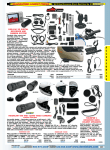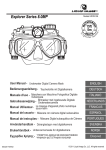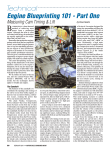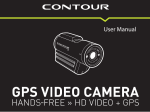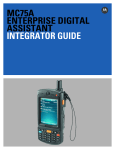Download V.I.O POV.HD Specifications
Transcript
Product Comparison Helmet Cam Shootout—Round Two Hi-Def Raises the Bar B June 2009 issue, when we ran our first helmet-cam comparo, HD (high definition) wasn’t available, but it’s now pretty much standard among today’s serious contenders. For Round Two, we’ve brought back the (tied) winners from Round One, in their new HD trim: GoPro’s HD Motorsports Hero and Contour’s HD1080P (formerly Twenty20’s VHoldR). Challenging these returning champs are several diverse HD models with a variety of features that make them highly competitive: V.I.O.’s POV.HD—an expensive setup with separate camera head and recorder, Drift Innovation’s HD170 Stealth—a self-contained unit with integrated LCD screen, and Liquid Image’s Impact Series 365— an off-road-oriented model with the camera built right into a set of goggles. Finally, we’ve included one standarddefinition helmet-cam that wasn’t in Round One, MotoComm’s RiderCam 30F, to see if HD’s benefits justify its higher price. Note: Shortly before this article went to press, Drift sent us a pre-production sample of the updated HD170 Stealth. The new unit, called simply the “HD,” functions exactly the same, but comes in a lighter, smaller package. As our HD had not received its final software optimization, we used the HD170 Stealth for comparisons of video and audio quality. But since both will be available by the time you read this, we’ll include info on the new HD (clearly designated) where appropriate. For those of you who missed the ’09 comparison, a few warnings still apply. First, even with the myriad mounting options available, any particular helmet may have a surface irregularity that precludes locating the camera where you want. You may also have reservations about attaching a permanent base-plate with a powerful adhesive to your fancy graphics. These caveats obviously apply to bike-mounting, too, along with the possibility that vibration may be more of a problem without your bump- and buzz-absorbing flesh in-between the motorcycle and camera. Also, with a bike-mount, you can’t capture interesting sights to either side with a simple turn of your head. Our biggest frustration in the previous test was the inability to confirm what the camera was actually “looking at,” since none of those earlier cams had a preview screen. We wasted many hours recording rides, only to discover—at playback—that all we’d caught was sky or the ground rushing by a few feet ahead. Some trial-and-error will inevitably be involved in achieving the aim you want. Obviously, it’s best if you can do this by pulling over and checking the footage a few minutes into a ride. Built-in LCD screens make this possible. ACK IN THE Tech Talk Since helmet cams have become more technologically sophisticated, we’ve included more detailed specifications, some of which may be unfamiliar to those without a background in photography or video equipment. Here’s a quick rundown. Just like that giant flat-screen TV in your den, HD cams may be capable of 720p (1280 x 720 pixels) or 1080p (1920 x 1080) resolution and some here also offer 960p (1280 x 960) as well. Basically, the higher the number, the finer the image; more detail translates into larger file sizes and images that still look sharp and clear when viewed full-screen. 24 by Mark Barnes DECEMBER 2011 ● MOTORCYCLE CONSUMER NEWS Size may matter: Center from left to right: GoPro, MotoComm, Contour, Drift HD, Drift Stealth (with remote). Liquid Image goggle-cam (top left) and V.I.O. (below right with corded controller) are entirely different animals. Recording at 720p and 1080p has a wide-screen aspect ratio of 16:9, whereas 960p has a 4:3 ratio (like a 35mm camera), which catches more of what’s happening above and below the frame centerline. Standard-definition settings of QVGA (320 x 240) and VGA (640 x 480) also have 4:3 aspect ratios; WVGA (848 x480) has 16:9. Higher resolution also means less “footage” will fit on your memory card and older computers can have trouble playing HD files. It also limits the smoothness of action recording because HD cameras can’t do 1080p recordings at the same “frame speed” as 720p. Frame-rate, expressed in frames-per-second, is limited to 30fps at 1080p, but most of these cams can go up to 60fps at 720p (standard Hollywood films are 24fps, by comparison). The faster the frame-rate, the more continuous the flow of movement on the screen; slower frame-rates can look a little “jumpy,” since more happens in-between the captured moments. Recording at 60fps also provides better slow-motion replay later (to study your bike’s suspension action, for instance), if your multimedia software allows. A related factor is bit-rate, which is a function of file compression. Some cams here allow you to adjust the quality of the recording by employing more or less compression as the file is saved; high bit-rate/low compression means more of the data collected by the sensor is preserved in the file, and vice-versa. Again, more data means larger files and less footage for any given card capacity; it’s also more demanding on the memory card and the playback computer. We’ve included the manufacturers’ claims of recording time at each unit’s highest quality settings; lower settings can greatly increase recording time storable on a given card. Lenses here differ in several ways. Focal range is the span of distance from the camera that will appear in-focus; this is relevant if you are trying to include something close to the camera (i.e. your speedo) along with the scenery. In general, we found all the cameras capable of maintaining proper focus at distances less than the minimums specified by their manufacturers. A lens’s aperture rating is basically the amount of light that can enter the camera; lower numbers mean the camera can still “see” in dimmer light. Some cams also offer metering choices for control over how they regulate their light sensitivity. Centerweighted metering, for example, gives exposure priority to the middle of the frame, even if it means under- or over-exposing the edges. This will preserve image details straight ahead while riding under a bright sky or through a dark corridor. Exposure compensation, which allows for an overall increase or decrease in light sensitivity, is available on some models. Field of view (FOV), defines how much of the scene a lens will capture. Wider angles require less precise aiming and include more of what we normally see with our peripheral vision, but they also make any one thing (like the rider ahead) smaller and less distinct. Ultra-wide angles also cause some “fish-eye” distortion. Two more lens issues: First, since a lens on a moving vehicle is subject to impact from vegetation or airborne debris, it’s worth noting that the GoPro and V.I.O. cover theirs with easily replaceable shields. Extra protection is available for the Contour and both Drifts in the form of optional waterproof cases. Lens replacement kits are also available for the GoPro, Contour and the updated Drift HD. Second, given that these cams may be mounted at lots of odd angles, it’s important that most can rotate their lenses to get the horizon level, independent of camera tilt. The Contour and both Drifts have lenses that swivel on their cases, and the tubular camera bodies of the V.I.O. and MotoComm can be rotated in their mounting brackets. The GoPro’s clever mounting brackets have swiveling hinges, some at right angles to each other, that allow the camera body to be tilted through wide arcs. This makes leveling possible, but can also cause the camera to stick out farther— either an advantage or a liability, depending on the situation. Finally, because HD recordings are very data-rich, recording and playback can be compromised by the use of low-grade memory cards. High-speed cards are more expensive, but they allow the cams to fully exploit high-resolution and fast frame- and bit-rate settings. Look for cards rated at least “Class 4” and even faster cards in some cases (e.g. V.I.O. recommends Class 6 for its “high” bit-rate setting, and a Class 10 for “very high”). The Contenders Our selections aren’t the only helmet-cams available, and comparing some of these to each other is an “apples to oranges” affair. We deliberately tried to get a broad sample, thinking that different designs would win out in different applications. Before you choose your own winner, make sure to visit each manufacturer’s website to see the accessories available. All but MotoComm and Liquid Image offer lots of extras, and the addition of one or more of those may change which cam suits you best. All but the MotoComm record video using the H.264 codec and save files in the common .mov and/or .mp4 format, which can be played back with most any multimedia software already on your computer (i.e. Quicktime). The MotoComm uses the .avi file format, which is also readily utilized. All connect to computers (PC or Mac) via included USB cables, and all but the Contour supply A/V cables for playback on adequately equipped TVs. All include rechargeable Li-Ion batteries except the V.I.O., which comes with four alkaline AA batteries (upgrade to Li-Ion rechargeable batteries at your own expense). Finally, all use either a MicroSD/SDHC or SD/SDHC memory card, most with 32GB maximums. Some come with (modest capacity) cards, others don’t. Every cam here has some degree of protection against moisture, ranging from the 60-meter depth rating on the GoPro’s waterproof case to the “water-resistant” Contour and Liquid Image units. The others are claimed to be waterproof at shallow depths for limited times. They should all hold up fine against the occasional splash. But, regardless of weatherproofing, using any of them in really wet conditions isn’t practical because any water droplets on their lenses will blur the scene. Differences in video quality turn out to be rather subtle among the cams here capable of 1080p. We figure buyers will make their selections based more on feature sets and available options, so we’ll cover those in greater depth and dispense with splitting hairs about picture quality. GoPro HD Motorsports Hero Ease of Operation: ::::. Video Quality: ::::; ::::: :::;. Mounting Options: Features: ::::: ::::. Value: Accessories: Comment: Highly competent but missing a couple of key features $299.99/$379.98 Audio Quality: ::::; (w/LCD BacPac ::::;) (w/LCD BacPac ::::;) Total Score: 61 or 64 w/BacPac Sensor Size: 5 MP Resolution: 1080p, 960p, 720p Frame Rate: 30fps (1080p, Recommended 960p, 720p), 60fps (720p) Focal Range: .6m to infinity Aperture: f/2.8 Field of View: 127° (1080p), 170° (720p) Battery Charge Life: 2.25 hours (claimed) Card Type: SD/SDHC (32GB maximum) Record Time: 6.4 hours in 1080p on 32GB card (claimed) Computer Compatibility: Windows ME, XP, Vista, 7, Mac OS X 10.2 and higher Warranty: 1 year Included with camera: Waterproof housing with swivel/quick-release mount; suction-cup mount with articulated arm; 2 curved and 3 flat adhesive base-plates; 3-way pivot arm; USB, analog and digital A/V cables; Li-Ion battery challenging; we had to keep referring to the GoPro’s instructions GoPro Impressions: The GoPro is the smallest of the self-contained units, although long after we’d dispensed with such aids for the other cams. We can understand GoPro’s placement of the Hero’s “shutter” its case (required for all mounting configurations) and our preferred suction-cup mount make it the bulkiest and heaviest once (rec/stop) button at the top-right, in the location people would mounted on a helmet. Basic operation is simple, with two buttons expect, given that it’s shaped like a regular hand-held camera and that are easy to locate and use with gloves on. However, reading right-handed operation would be preferred by the vast majority of its tiny LCD screen icons and cryptic codes during setup can be non-motorcycling users. But this means we either have to take o Visit us at WWW.MCNEWS.COM ● DECEMBER 2011 25 Product Comparison our right hand off the throttle, or fumble with our left for the button while trying to keep our fingers away from the lens. Also, its signal beeps (to indicate on/off and rec/stop) are barely audible with a helmet on. The GoPro offers the full range of HD resolution/frame-rate combinations, as well as still-image capability and its lens is tied for the widest angle. We know from previous testing that its protective case can withstand rough use. Two case hatches are provided—one with a waterproof seal and one with openings that allow enhanced audio recording. This is useful, given the lack of adjustable mic sensitivity. Features include auto, center-weighted or spot metering, a 10second self-timer for taking a photo after stepping away from the camera, a 3-photo burst option, “time-lapse” photo intervals from 2–60 seconds, and a “one-button” mode that combines on/off with rec/stop to further simplify operation and conserve battery life. The LCD BacPac accessory adds a great deal of utility, serving as a viewfinder and allowing in-field playback (with sound and fast-forward/rewind) on its 2" (diagonal) screen. It comes with swappable hatches (waterproof and audio-enhancing, just like the cam)—to accommodate its additional depth. It’s well worth the additional $79.99. We loved the suction-cup mount’s versatility and strength during Round One (it hung on even when knocked by branches during trail-riding). It’s still great, especially if a permanent adhesive option is unwanted. However, even the height of a decal can be enough to defeat any suction-cup’s seal at its edge. Using an adhesive mount can keep the GoPro closer to a helmet’s surface, but reduces adjustability. The waterproof hatch seals out almost all sound; what’s left is tinny and artificial. The audio-enhancing hatch allows realistic, full-spectrum sound without terrible wind noise. Engine sounds are clear, but it’s very hard to hear the rider’s voice, even when he shouts. Color is true, and there’s good detail in brightly lit zones, but we wanted to increase overall light sensitivity a tad and missed exposure compensation. GoPro—2450 Cabrillo Hwy. South, GoPro’s optional $79.99 LCD BacPac serves as a viewSuite 250, Half Moon Bay, CA finder allowing aiming capability as well as in-field 94019; 888-600-4659; playback and rewind and includes a special hatch. www.gopro.com Contour HD1080P $249.99 Ease of Operation: ::::. Video Quality: ::::. Audio Quality: ::... :::;. Mounting Options: ::::. Features: Accessories: ::::. ::::. Value: Total Score: 51 Comment: Simple, strong and effective, with a few serious limitations Recommended Sensor Size: 5 MP Resolution: 1080p, 960p, 720p WVGA Frame Rate: 30fps (1080p, 960p, 720p), 60fps (720p WVGA) Focal Range: .5m to infinity Aperture: f/2.0 Field of View: 110° (1080p), 135° (960p, 720p) Battery Charge Life: 2.5–3.0 hrs (claimed) Card Type: Micro SD (32GB max) Record Time: 8 hours in 1080p on 32GB card (claimed) Computer Compatibility: Windows ME, XP, Vista, 7, Mac OS X 10.5 and higher Warranty: 180 days. extended to 1 yr. if camera is registered and a video is shared on Contour’s user-community website. Contour Impressions: The Contour’s simplicity is both an asset and a liability. On the positive side, its large slide control for rec/stop is very easy to use with gloves on, and there’s never any doubt which position it’s in. (Even good buttons occasionally left us wondering if they were pushed hard enough, and we sometimes lost track of whether we’d last turned them on or off.) Several LEDs on the cam’s body provide general status info, such as warnings that battery life or card memory is running low. The signal beep is less of a concern because of the rec/stop control design, but it’s generally audible through the helmet. Basic mounting hardware allows the cam to be slid into/out of place quickly and easily, yet provides a reassuringly secure hold. Ironically, it’s the only cam here with a tether for insurance. This cam is the most solid-feeling, with sturdy brushed aluminum construction that we know holds up under 26 DECEMBER 2011 ● MOTORCYCLE CONSUMER NEWS abuse—we fell on our last one several times while trail-riding, scuffing it up quite a bit, with no functional damage. The new HD version’s body is identical. We’d like to see Contour include more than just two mounting options, but they’re both tough and welldesigned, although the adhesive base-plate won’t accommodate more than a mild surface curvature. The downside of this cam’s simplicity is two-fold: there’s no way to check your footage in the field, and virtually all of its adjustments must be made while hooked up to a computer (you do get to select user-defined hi- and low-res settings with a switch inside the rear hatch). Contour supplies a rudimentary video editing program that’s also the control center for the cam’s software settings. So, unless you carry your laptop with you on rides, you’ll have to live with whatever settings you chose before you left home. Those user-definable settings are quite extensive, and include bit-rate (high, medium, low), metering (average, center, spot), and +/- 4 steps of exposure compensation, along with variable contrast, sharpness and mic sensitivity. But these are exactly the kinds of things we’d want to be able to adjust over the course of a ride through changing conditions. The Contour retains its predecessor’s unique and clever laser leveling system. Upon startup (and on call, thereafter), two lasers on the cam’s face allow you to twist the lens until the red dots they throw onto a vertical surface in front of you are level. This gets the horizon even, and gives you some idea of where the cam is pointed, but it doesn’t tell you where the camera will actually be looking during a ride. You may wind up with a very level view of the road passing under your front fender, because it’s easy to misjudge your “riding” position while you’re sitting still on your bike, aiming the cam. Even more clever is a setup available for another hundred bucks on a different Contour model, one that incorporates a GPS receiver that will log your location continuously and can show it graphically along with your video footage. There’s a smartphone app (and additional $30 piece of hardware) for that model that allows you to use your phone’s screen as a viewfinder; the camera sends its image there wirelessly via BlueTooth in real time and allows in-field setting adjustments. But, even the GPS/smartphone combo doesn’t address the Contour’s lack of still-image capability and very limited stock mounting options (others are available as accessories). The folks at Contour are really invested in expanding their online video-sharing community. The above-mentioned video editing software also serves as a convenient platform for uploading clips to Contour’s website. We’re all for community-building, but it seems a bit over-the-top to us to require the sharing of a video to get the warranty bumped up from 180 days to one year, and we found the persistent pop-up reminder to register the cam annoying. Other (possibly much better) video-editing software may already be sitting somewhere on your computer. As in Round One, we prefer the less fish-eyed FOV of the Contour over the ultra-wide-angle GoPro (and Drifts). Color is slightly flat, and metering and contrast required some tweaking to suit us; details lacked a little sharpness. The Contour’s mic is extremely vulnerable to wind noise, which is obnoxious and drowns out everything above 30mph. At lower speeds, engine noises lack low-frequency resonance (for instance, your big twin will sound like a lawn mower). Contour, Inc.—3131 Western Ave., Seattle, WA 98121; 206- 792-5226; www.contour.com oPro HD Motorsports Hero Price $299.99 Drift Innovation HD170 Stealth & HD $349–$369 Ease of Operation: ::::; Video Quality: ::::: ::::: Mounting Options: ::::; Features: ::::; ::::: Value: Stealth HD Comment: You can’t beat the Drift HD’s size/functionality Audio Quality: :::.. Accessories: ::::. Total Score: Stealth 61, HD 62 BEST BUY! Sensor Size: 5 MP, 9MP on HD Resolution: 1080p, 720p WVGA Frame Rate: 25 or 30fps (1080p, 720p), 60fps (720p WVGA) Focal Range: .5m to infinity Aperture: f/2.8 Field of View: 127° (1080p), 170° (720p WVGA) Battery Charge Life: 2.5–3.0 hrs. (claimed) Card Type: SD/SDHC; Micro SD/SDHC for HD (32GB max on both) Record Time: 6 hrs. in 1080p on 32GB card (claimed) Computer Compatibility: Windows ME, XP, Vista, 7, Mac OS X 10.4.11 and higher Warranty: 1 year Included with Stealth: RF remote control, 12" hook and loop strap, 24" adjustable elastic strap, goggle-strap mount, curved-surface base-plate (can be used with strap or adhesive), handlebar mount, quck-release mounting clip, assorted adhesive pads, USB, analog & digital A/V cables, Li-Ion battery. Included with HD: Same as above, except for new combined goggle-strap mount/curved surface base-plate (for use with strap, not adhesive), adhesive flat-surface base-plate, adhesive curved-surface base-plate, and additonal rear hatch with outlets for external mic and USB power source. Drift Stealth & HD Impressions: Compared to the GoPro and Contour, the Stealth initially seems ungainly, while the HD is much sleeker (about the same size as the Contour). Add the suction-cup mount to the GoPro, though, and the Stealth is easily back in the hunt. The Drift units’ adhesive mounts are simple and secure, with a solidly engaging quickrelease clip. The HD’s base-plates are a small improvement over the Stealth’s. Operation is easy with gloves off, but the small, flush buttons can be very hard to locate with gloves on and the cam out of sight during use. Fortunately, the wireless remote control renders this moot; it can be worn on a wrist band or mounted in a convenient spot. Signal beeps are the most clearly audible of any here, but can still be drowned out by wind noise. Navigating the Drift menus (virtually identical on both models) is straightforward and intuitive, but the text and icons are tiny and cramped on the 1.5" LCD screens. Said screens are nevertheless fully adequate for previewing recordings or serving as a viewfinder, and we value these functions very highly. While we didn’t happen to crash test either Drift, they’re both constructed of Visit us at WWW.MCNEWS.COM ● DECEMBER 2011 27 Product Comparison ABS plastic with a rubbery coating and appear sturdy. That said, their LCD screens add significant vulnerability to impact. Features include adjustable mic sensitivity and exposure compensation (+/- 2 steps), with a special “night mode” for low-light conditions and still-images can be taken singly or in “time-lapse” fashion at user-defined intervals every 2-30 seconds. Frame-rates include Euro-spec speeds, and a standard 1/4" threaded hole allows mounting on tripods and accessory brackets. The Drift cams are the only ones here that offer (digital) zoom capability, allowing you to narrow their wide fields of view, but at some cost to image quality. The HD has a Micro-HDMI jack for optimizing direct playback on an HDTV. Like the V.I.O., both Drifts allow use of an external microphone. This is of critical importance if you want to add commentary to your recording along the way, since wind noise severely compromises the ability of on-camera mics to clearly capture voice input in most situations. Because the Stealth’s mic jack is a unique shape, it requires Drift’s proprietary accessory mic, although an adapter is available to allow generic connections. The HD has a standard 2.5mm mic input jack. Using an external mic on the Stealth requires leaving its hinged rear hatch open, although some The Drift plugs into a variety of provided base-plate arrangements. limited measure of weatherproofing is restored by slipping a clumsy silicone boot (sold separately) over the rear end of the with the Stealth yields better voice recording and more realistic cam. The HD comes with an alternative rear hatch for external engine sounds, but it isn’t as clean as using a condenser mic with mic use; it’s very tidy and more water-resistant—far superior to the the HD. Video quality is on par with the GoPro’s, with more vivid color and better metering (even without adjustment), but slightly Stealth’s afterthought solution. The Stealth’s on-cam mic does an okay job. Wind noise is tol- less detail in bright zones. erable, and it’s (barely) possible to make out what the rider shouts Drift Innovation c/o MyPOV360 (U.S. distributor)—P.O. Box at speed, but low-frequency sound isn’t as good as with the Hero, 284; Boyne City, MI 49712; 704-966-9768; Impact or POV.HD. Using the proprietary (non-condenser) mic www.driftinnovation.com or www.mypov360.com Liquid Image Impact Series Ease of Operation: ::::; Video Quality: :::;. ::::. ::... Mounting Options: Features: ::::. Value: Comment: Maximum convenience, but significant limitations $250.00 Audio Quality: ::::; Accessories: ::... Total Score: 49 Sensor Size: 5 MP Resolution: 720p Frame Rate: 30fps Focal Range: 1.2m to infinity Aperture: f/3.2 Field of View: 135° Battery Charge Life: 2 hours (claimed) Card Type: Micro SD/SDHC (32GB maximum) Record Time: 9 hrs. on 32GB card (claimed) Computer Compatibility: Windows XP, Vista, 7, Mac OS X 10.4 and higher Warranty: 90 days Included with camera: Nose guard, extra goggle lens, 7 tear-offs for goggle lens, microfiber carrying pouch, USB & digital A/V cables, Li-Ion battery, 4GB MicroSD card o Liquid Image Impression: The Liquid Image offers more convenience than any other cam here, with no mounting necessary and very simple operation via two large buttons on the right edge of the goggle frame. These buttons are easy to find and use with gloves on, but we wish they were located on the left side, where they’d be much more easily operated by our non-throttle hand. Said buttons reside on a hinged “wing” that holds the strap end and swings outboard of the goggle frame to accommodate different size/shape helmet eye-ports. The rear of the wing opens to accept the MicroSD card and MicroUSB jack. (The left wing holds the battery.) Compared to premium non-cam-equipped goggles, these are quite bulky and clumsy. But they avoid the even more awkward setup of a camera mounted on the outside of a helmet, not to mention the latter’s far greater vulnerability to impact. For use in very dusty or muddy conditions, the Liquid Image comes with seven “tear offs” that can be affixed to posts on the goggle lens and then pulled off when they load up with vision28 DECEMBER 2011 ● MOTORCYCLE CONSUMER NEWS obscuring filth. This is a nice feature on any off-road goggle, but there’s no provision for keeping the camera lens clean. So, if you’re recording, you’ll have to stop and tend to the camera, anyway, and could just wipe off the goggle lens at the same time. Because there aren’t a host of user-selectable settings, the tiny LCD screen located above the bridge of the nose inside the goggle frame is adequate for what little information it has to convey (battery life, video/still-image mode, number of files saved). And, because the cam is essentially “inside” the helmet space, its signal beep is audible in most situations. You simply turn the cam on, select video or still-frame mode, and then press the rec/stop button when you’re ready to shoot. Although Liquid Image expects to release a full 1080p version of the Impact this fall, the current unit only records in 720p at 30fps. Given that its design is for off-road use, we’d really have preferred recording at 60fps, like we could with the other HD cams in 720p mode. Scenery rushing past is often much closer to the camera during off-road riding, and the relatively choppy motion of the slower frame-rate is therefore more pronounced. But even on the road, this cam had the choppiest video of this group. Unlike any other cam here (except possibly the V.I.O., depending on where you stow its recording unit), the Liquid Image gives you a visual signal that confirms its operation. An LED adjacent to its LCD screen changes color and flashes to indicate its mode and whether or not it’s recording. This is barely visible during use —just enough to allow checking it, but not enough to be distracting. We really appreciated this feature. Our only semi-serious complaint about the Liquid Image is that its frame is taller/stiffer than other goggle brands we’ve used. This wouldn’t be an issue if we were just wearing the goggles by themselves, like a skier would. But with the goggles wedged under the front edge of a helmet eye-port, there was excessive downward pressure at the bridge of the nose. This was relieved to some extent by removing the included nose guard—an add-on that, along with the impact-resistant/tear-offaccommodating goggle lens, distinguishes the Impact from Liquid Image’s snow-skiing model. Depending on your bone structure and helmet shape, you might experience significant discomfort on extended rides. Of course, the Liquid Image lacks our favorite feature—a screen that acts as viewfinder and allows reviewing recorded footage. However, it’s less of an issue here, since the cam can’t be misaligned (though it does point slightly lower than we thought we were looking). Color is rich, but detail can be a little weak in brightly lit or darkly shaded zones. This cam’s mic picks up surprisingly little wind noise; voice is recorded crisply and cleanly, and engine sounds are realistic. We’d like to see the Impact remodeled with more consideration for the differences between snow-skiing and motorcycling. A slightly shorter/softer frame, tear-offs that protect the camera lens, and rearranged buttons would be all it would take, though we realize it may be necessary at this stage in the product’s evolution to share as much as possible with already existing models. Liquid Image Co., 7909 Walerga Rd., Suite 112-206, Antelope, CA 95843; (916) 721-4848; www.liquidimageco.com oPro HD Motorsports Hero Price $299.99 V.I.O. POV.HD $599.95 Ease of Operation: :::;. Video Quality: ::::; :::.. ::::: Mounting Options: Features: :::.. Value: Comment: Many features, but not so great as a helmet cam Audio Quality: ::;.. Accessories: :::.. Total Score: 49 Sensor Size: 2 MP Resolution: 1080p, 720p Frame Rate: 24, 25 or 30fps (1080p), 25, 30, 50 or 60fps (720p) Focal Range: .7m to infinity Aperture: f/2.0 Field of View: 142° (1080p), 95° (720p) Battery Charge Life: 2.5 hrs alkaline, 5 hours for Li-Ion (claimed) Card Type: SDHC, Class 6 or higher, 32GB max Record Time: 4.33 hrs. on 32GB card (claimed) Computer Compatibility: Windows Vista, 7, Mac OS X 10.5 and higher Warranty: 1year Included with camera head: Recorder unit, 1.5m camera cable, RF remote control, 2 camera head brackets, flat- or curved-surface base-plate (can use adhesive or unique magnetic clamping system), goggle-strap mount, 28" adjustable elastic strap, 12" hook & loop strap, assorted adhesive pads and zip-ties, carrying case, USB and analog A/V cables, (4) AA alkaline batteries, 4GB SDHC card V.I.O. Impression: In our original helmet-cam article, we chose not to test units with separate camera heads and recorders, and cited the drawbacks of a) having to find a place to stow the recorder, b) difficulties operating the recorder in its stowed location, c) the hassle of routing a connecting cable, and d) much higher cost. But we also noted the theoretical advantages of having dedicated pieces that might outperform a smaller combo unit; after all, this is true in other types of electronics. Is it true here? Sort of. The V.I.O. is the most feature-packed unit here, with variable mic sensitivity, bit-rate (4 levels), metering (average or spot), exposure compensation (+/- 3 steps), image resolution and framerate (including Euro-spec varieties), along with toggles for picture sharpening and video “noise” filtering. These and more user-definable options are easily managed via straightforward menus. The range of adjustments is likely overkill for most users, but allows maximum control for those who want it. Once all the settings have been chosen, the recorder can be stowed without concern about its accessibility while riding, since a wireless remote control starts and stops recording (or takes snapshots in still-image mode). Like the Drifts’ remotes, it can be strapped to a wrist or other easily reachable location. The recorder’s signal beeps are easily rendered inaudible by storage in a tankbag or backpack. The remote can also “tag” moments for use later as reference points during playback, and tagged segments can be split out or compiled within the recorder itself, so some basic editing can be done in the field. You can even fast-forward and rewind at different speeds during playback. But we think the most unique and valuable feature of the V.I.O. is its ability to record action before you press the button. How’s that possible? Depending on the mode selected, the V.I.O. can actually be recording constantly, and discarding footage that has “aged” some defined amount of time without a command to “record”—which Visit us at WWW.MCNEWS.COM ● DECEMBER 2011 29 Product Comparison is to say, save what has been recorded. For example, you might set it to discard recorded footage after 30 seconds if you haven’t hit the record button. This means that whenever you do hit record, the saved file will include the 30 seconds of action prior to that command, along with what follows. You never know when something cool will happen unexpectedly. But, if you were recording the entire ride to ensure the capture of such a choice moment—you’d have to wade through a huge quantity of unwanted footage to find it later. So, the V.I.O. gives you 20-20 hindsight you can actually use! This feature alone may be worth its extra expense and hassle. We don’t have room here for all the details, but you can download the manual from V.I.O.’s website and read the section entitled, “Understanding the POV.HD Video Record Methods.” Files are saved with handy names that incorporate the date and time they were recorded, along with tag-related information. Sensor size is apparently not directly related to video quality, as the V.I.O. gives away 3MP to the other HD units, yet has comparable detail, clarity and color saturation; it’s most similar to the GoPro, image-wise. Metering requires some tweaking, and is a bit hyper-reactive, briefly overcompensating for shifts in scene brightness caused by simply turning a little to the right or left; up/down movement yields even more of this because the sky is usually the brightest part of the scene. (We doublechecked to make sure we weren’t using spot metering, which can sometimes produce this effect.) Audio is quite good as long as speeds are very low, but the cam’s mic is extremely sensitive to wind noise, which becomes a din above 25mph. Because the V.I.O.’s mic is located at the midpoint of its cam-to-recorder cable, it could conceivably be secured out of the wind blast and perhaps even near the rider’s mouth. However, in most cases it’d be far more practical to use a lavaliere mic with a separate, longer cord. When we did so, we got excellent voice and engine sound, with minimal wind noise. Note that using the V.I.O.’s external mic jack requires removal of the recorder’s end-hatch, seriously compromising its waterproofing. Speaking of cords and practicality, the V.I.O. is profoundly awkward to use, compared to the other cams here. While the separate recorder’s 2" (diagonal) LCD screen does provide the lone viewfinder here that’s actually visible to a rider during use, this is only true if it’s mounted somewhere in the rider’s field of vision, and it’s a big, heavy 10 oz. brick to find a home for. Stowing it in a bag or using an accessory mounting system doesn’t address the cable routing issue, which can really complicate the process of getting on and off the bike, or putting on/taking off a helmet, since there’s no way to quickly release the camera head from the recorder. (But if both are mounted on the bike, these problems vanish.) We would definitely not want to contend with this setup off-road; the camera cord would be vulnerable to snagging, and we don’t like the idea of having our helmet (and head!) tethered to wherever the recorder is stored in the event of a spill (much more common offroad). However, the V.I.O.’s heavy-gauge aluminum camera head, thick cable and rugged plastic recorder look like they’d survive very rough conditions. This is an impressive piece of equipment; we’re just not crazy about it as a helmet-cam, and we’re dubious about the cost of its (admittedly long) list of features. V.I.O.—100 N. Front St., Marquette, MI 49855; 888-579-2267; www.vio-pov.com MotoComm RiderCam 30F Ease of Operation: ::::. Video Quality: ::... :.... Mounting Options: ::... Features: ::... Value: Comment: Seriously flawed, even compared to non-HD cams $189.99 Audio Quality: :.... Accessories: :.... Total Score: 26 Sensor Size: 1.3 MP Resolution: VGA, QVGA Frame Rate: 30fps Focal Range: 6" to infinity Aperture: f/2.0 Field of View: 90° Battery Charge Life: 2 hours (claimed) Card Type: Micro SD/SDHC (8GB maximum) Record Time: 4 hours on 8GB card (claimed) Computer Compatibility: Listed only as PC and Mac Warranty: 1 year Included with camera: Handlebar mount, 24" rubber strap, 24" hook & loop strap, 12" hook & loop strap, flat-surface mount (can be used with adhesive or straps), assorted adhesive pads, silicone grease (for waterproofing its rubber grommets), USB and analog A/V cables, Li-Ion battery, AC charger MotoComm Impressions: Unfortunately, the most salient aspect of the MotoComm is its 30 DECEMBER 2011 ● MOTORCYCLE CONSUMER NEWS severely limited mounting options. Even when compared to the non-HD units we tested back in Round One, this cam falls short. During that first comparo, we wound up doing most of our testing on dirtbike helmets because they afforded visor slots through which we could thread those cams’ hook & loop straps (the only viable mounting options for some of our contenders, which were clearly designed for mountain-bikers, rather than motorcyclists). However, we couldn’t figure out a satisfactory way to mount the MotoComm to a dirtbike visor using the hook & loop straps it came with, and MotoComm doesn’t offer any mounting accessories. We suppose there’s always duct tape… We’d initially rejected the possibility of mounting the MotoComm on a streetbike helmet because it comes with only a rigid flat-surface mount, but we ended up using that with the supplied small, adhesive-backed strips of hook & loop tape. This made for a very precarious setup, and we fashioned a zip-tie tether (secured to another camera’s mount) to catch it if it fell off. Surprisingly, the tape held during a few quick rides to gather sample footage. However, the adhesive peeled off of the helmet later that evening, just from supporting the weight of the cam. (The surface had been prepped with alcohol before application, just as with all the other adhesive mounts.) This serious problem with mounting makes the MotoComm’s features and performance largely irrelevant, if you want the cam on your helmet. True, purchasing a mount from elsewhere (e.g. the elegantly designed suction-cup mount from RAM) that could utilize the cam bracket’s 1/4" threaded hole might solve the mounting dilemma, but that would push the cost of this setup very close to the vastly superior alternatives here and that doesn’t strike us as a reasonable option. Nevertheless, here’s a summary of what the MotoComm has to offer—if you’re going to mount it on a flat surface with what comes in the box. (It does include more substantial double-sided adhesive pads than what we used, but they’re useless on curved surfaces like helmets which need a curved baseplate.) Operation is very simple via a single external button to arm and then start/stop recording, after a “battery on” switch is flipped inside the screw-on rear hatch, where another switch allows toggling between the two video settings (VGA and QVGA). Size of the polycarbonate/aluminum camera body is a little smaller than the Contour, and—aside from the aforementioned flimsy mount—the cam and bracketry seem fairly sturdy. The signal beep that is supposed to confirm that recording has started or stopped is virtually inaudible, even in a quiet room without a helmet on, and is completely useless during operation on a motorcycle. And, for reasons we don’t understand, upload speed for transferring footage from the cam to a computer was extraordinarily slow, despite the relatively small file sizes of these non-HD recordings. There’s no still-image function, this is the only camera here without a replaceable battery, and the manufacturer website is the least informative. Some of the other cams don’t come with memory cards, but—given the huge value discrepancy between the MotoComm and the others—it seems like a glaring omission here. As expected, this cam’s video quality is quite inferior to that of the others in this group. Edges and details are blurry if the playback window is larger than about 5" (diagonal), and the narrow FOV looks cramped. We certainly don’t fault the MotoComm for this, since it’s not an HD cam. Its recordings compared favorably to some footage saved from the earlier non-HD shootout, with above-average color accuracy, metering and contrast. Sound quality, however, is atrocious, with nothing but wind noise audible above 25 mph and only a faint, tinny reproduction of engine sounds at lower speeds. MotoComm—P.O. Box 445, Issaquah, WA 98027; 877-624-6869; www.motocomm.com Parting Shots At the outset, we expected to end up recommending the costly V.I.O. to serious videographers, who would consider its extensive manual controls worth its much higher price. And we expected to find the MotoComm a good choice for those seeking a cost-effective alternative to the current crop of higher tech cams. Neither of these predictions proved correct. The V.I.O., for all its complexity, is rendered quite impractical by its physical characteristics, and it offers little performance advantage for the vast majority of potential users. And the MotoComm, even with its low price, is still a poor value, considering how terribly inferior it is to its HD rivals in terms of recording quality, features and mounting hardware. We might consider it a viable option at half its MSRP. We had another erroneous expectation at the start, too. We thought these manufacturers had such diverse takes on how to build a helmet-cam that no single design would tower over the others in its desirability, but “one” certainly does: the Drift HD170 Stealth and its smaller update, the HD. Even the slightly pricier HD, with its integrated LCD screen, comes in a few bucks beneath the GoPro with an accessory LCD BacPac—and the Drift is eas- ier to use (menus, remote). Both Drifts have all the important adjustments, video quality as good as any other cam here, and simple, effective mounting hardware—plus remotes! Granted, if you want to address their relatively weak audio performance you’ll have to spend another 20-35 bucks on an accessory microphone, but at least the Drifts provide that choice. For an extra C-note or so, the Drifts are far more versatile than the Liquid Image or Contour—and we can’t emphasize enough how much we value that integrated LCD screen. Or, if you’re an off-roader that loves the idea of simply pulling on some goggles to start recording, buy the Liquid Image. If you’re looking for an economical HD helmet-cam and don’t mind taking a few rides to get it aimed and setup just right, buy the Contour. If you want lots of great mounting options without spending additional money on accessories, buy the GoPro. But, if you want the helmet-cam that excels in almost every dimension, and you can accept that such a piece fetches a significantly higher price (which we feel is still a great value), one of the HD Drifts is the helmet-cam for you. Visit us at WWW.MCNEWS.COM ● DECEMBER 2011 31









